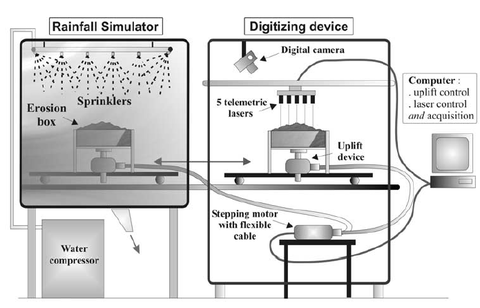We present the results of an experimental study of topography dynamics under conditions of constant precipitation and uplift rate. The experiment is designed to develop a complete drainage network by the growth and propagation of erosion instabilities in response to tectonic perturbations. The quantitative analysis of topographic evolution is made possible by using telemetric lasers that perform elevation measurements at an excellent level of precision. We focus our study on the effect of initial surface organization and of uplift rate on both the transient dynamics and the steady state forms of topography. We show that the transient phase is strongly dependent on the initial internally drained area, which is found to decrease exponentially with time. The topography always reaches a steady state whose mean elevation depends linearly on uplift rate with a strictly positive value when uplift is zero. Steady state surfaces are characterized by a well-defined slope–area power law with a constant exponent of 0.12 and an amplitude that depends linearly on uplift rate with a strictly positive value when uplift is zero. These results are consistent with a stream power law erosion model that includes a nonnegligible threshold for particle detachment. Uncertainty regarding the sediment transport length is resolved by calibrating the transient dynamics with a surface process model. Reappraising published results on the linear dependency between mean elevation, or relief, and denudation rate, we suggest that an erosion threshold is worth considering for large-scale systems.

Geolocation is 48.1132044, -1.6616030999999793